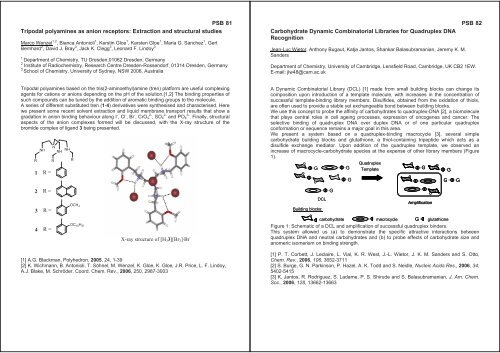ISMSC 2007 - Università degli Studi di Pavia
ISMSC 2007 - Università degli Studi di Pavia
ISMSC 2007 - Università degli Studi di Pavia
You also want an ePaper? Increase the reach of your titles
YUMPU automatically turns print PDFs into web optimized ePapers that Google loves.
PSB 81<br />
Tripodal polyamines as anion receptors: Extraction and structural stu<strong>di</strong>es<br />
Marco Wenzel 1,2 , Bianca Antonioli 1 , Kerstin Gloe 1 , Karsten Gloe 1 , Maria G. Sanchez 1 , Gert<br />
Bernhard 2 , David J. Bray 3 , Jack K. Clegg 3 , Leonard F. Lindoy 3<br />
1 Department of Chemistry, TU Dresden,01062 Dresden, Germany<br />
2 Institute of Ra<strong>di</strong>ochemistry, Research Centre Dresden-Rossendorf, 01314 Dresden, Germany<br />
3 School of Chemistry, University of Sydney, NSW 2006, Australia<br />
Tripodal polyamines based on the tris(2-aminoethyl)amine (tren) platform are useful complexing<br />
agents for cations or anions depen<strong>di</strong>ng on the pH of the solution.[1,2] The bin<strong>di</strong>ng properties of<br />
such compounds can be tuned by the ad<strong>di</strong>tion of aromatic bin<strong>di</strong>ng groups to the molecule.<br />
A series of <strong>di</strong>fferent substituted tren (1-4) derivatives were synthesised and characterised. Here<br />
we present some recent solvent extraction and liquid membrane transport results that show a<br />
gradation in anion bin<strong>di</strong>ng behaviour along I - , Cl - , Br - , CrO4 2- , SO4 2- and PO4 3- . Finally, structural<br />
aspects of the anion complexes formed will be <strong>di</strong>scussed, with the X-ray structure of the<br />
bromide complex of ligand 3 being presented.<br />
R<br />
1<br />
2<br />
3<br />
4<br />
NH<br />
R =<br />
R =<br />
R =<br />
R =<br />
N<br />
NH<br />
NH<br />
R<br />
R<br />
OCH 3<br />
OC 10H 21<br />
X-ray structure of [H33][Br3]·Br -<br />
[1] A.G. Blackman, Polyhedron, 2005, 24, 1-39<br />
[2] K. Wichmann, B. Antonioli, T. Söhnel, M. Wenzel, K. Gloe, K. Gloe, J.R. Price, L. F. Lindoy,<br />
A.J. Blake, M. Schröder, Coord. Chem. Rev., 2006, 250, 2987-3003<br />
Carbohydrate Dynamic Combinatorial Libraries for Quadruplex DNA<br />
Recognition<br />
Jean-Luc Wietor, Anthony Bugaut, Katja Jantos, Shankar Balasubramanian, Jeremy K. M.<br />
Sanders<br />
Department of Chemistry, University of Cambridge, Lensfield Road, Cambridge, UK CB2 1EW.<br />
E-mail: jlw48@cam.ac.uk<br />
A Dynamic Combinatorial Library (DCL) [1] made from small buil<strong>di</strong>ng blocks can change its<br />
composition upon introduction of a template molecule, with increases in the concentration of<br />
successful template-bin<strong>di</strong>ng library members. Disulfides, obtained from the oxidation of thiols,<br />
are often used to provide a stable yet exchangeable bond between buil<strong>di</strong>ng blocks.<br />
We use this concept to probe the affinity of carbohydrates to quadruplex-DNA [2], a biomolecule<br />
that plays central roles in cell ageing processes, expression of oncogenes and cancer. The<br />
selective bin<strong>di</strong>ng of quadruplex DNA over duplex DNA or of one particular quadruplex<br />
conformation or sequence remains a major goal in this area.<br />
We present a system based on a quadruplex-bin<strong>di</strong>ng macrocycle [3], several simple<br />
carbohydrate buil<strong>di</strong>ng blocks and glutathione, a thiol-containing tripeptide which acts as a<br />
<strong>di</strong>sulfide exchange me<strong>di</strong>ator. Upon ad<strong>di</strong>tion of the quadruplex template, we observed an<br />
increase of macrocycle-carbohydrate species at the expense of other library members (Figure<br />
1).<br />
O<br />
Quadruplex<br />
O<br />
O<br />
G<br />
G Template<br />
G<br />
G<br />
O<br />
Buil<strong>di</strong>ng blocks:<br />
O<br />
O<br />
DCL<br />
G<br />
O<br />
G<br />
O<br />
Amplification<br />
carbohydrate macrocycle G glutathione<br />
Figure 1: Schematic of a DCL and amplification of successful quadruplex binders.<br />
This system allowed us (a) to demonstrate the specific attractive interactions between<br />
quadruplex DNA and neutral carbohydrates and (b) to probe effects of carbohydrate size and<br />
anomeric isomerism on bin<strong>di</strong>ng strength.<br />
[1] P. T. Corbett, J. Leclaire, L. Vial, K. R. West, J.-L. Wietor, J. K. M. Sanders and S. Otto,<br />
Chem. Rev., 2006, 106, 3652-3711<br />
[2] S. Burge, G. N. Parkinson, P. Hazel, A. K. Todd and S. Neidle, Nucleic Acids Res., 2006, 34,<br />
5402-5415<br />
[3] K. Jantos, R. Rodriguez, S. Ladame, P. S. Shirude and S. Balasubramanian, J. Am. Chem.<br />
Soc., 2006, 128, 13662-13663<br />
O<br />
G<br />
G<br />
PSB 82

















